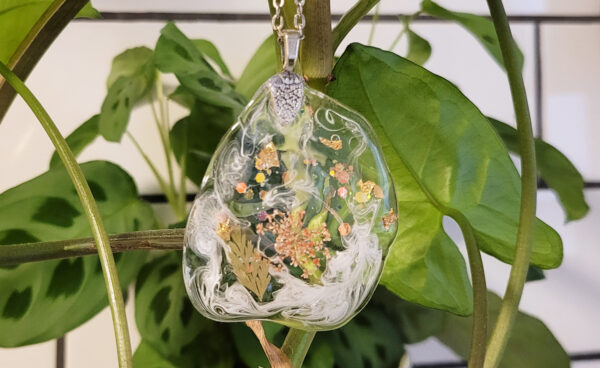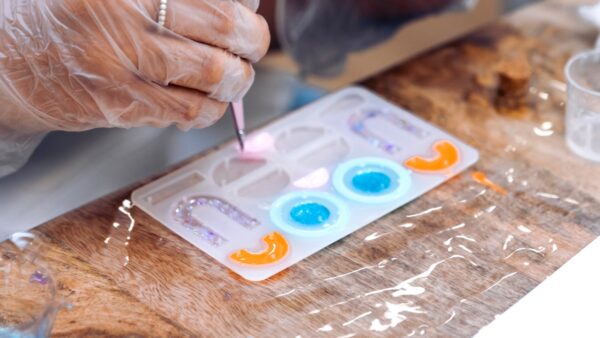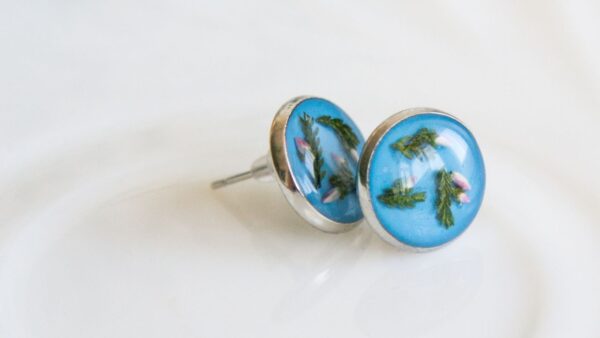How To Dry Flowers For Resin: 12 Different Ways
Here are the most popular ways to dry flowers to preserve them for resin. Preserving flowers in resin allows us to extend their natural beauty.
Whether you seek to immortalize a special bouquet, create personalized décor like a resin table with flowers, or learn more about floral preservation these tips will help you dry your flowers the right way.
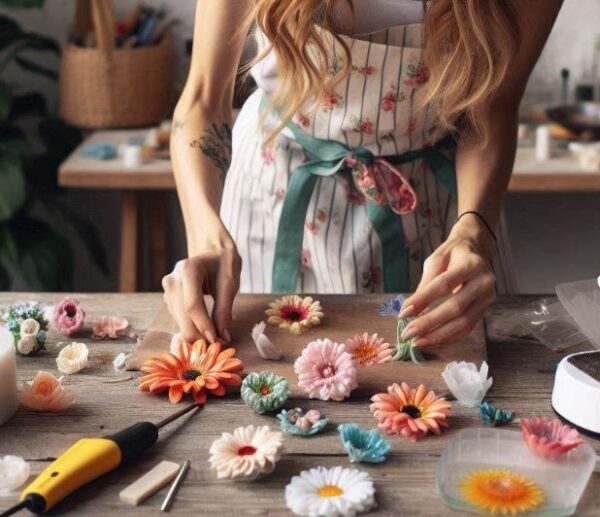
This guide will show the step-by-step process of drying flowers so that they will be completely dry and have no more moisture left. You can then go ahead to use in your resin creations like making coasters, resin flower trays and resin jewelry.
If you want to create pressed flower art, make personalized keepsakes, or simply enjoy their vibrant colors and delicate forms, there are many methods you can try.
Some of these ways will dry flowers quickly and then others will take longer, like drying your flowers inside books.
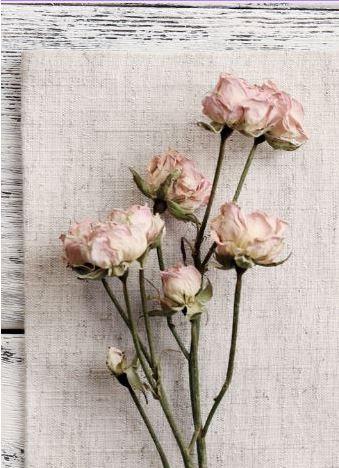
In this article, we will explore a variety of ways to preserve flowers. These will range from traditional techniques like pressing and air drying to microwave pressing and resin embedding.
No matter what method you use from this list, always do a test piece before jumping in with keepsake flowers. Make sure the method you choose is the right one for the particular flowers you will be preserving.
BEST WAYS TO DRY & PRESERVE FLOWERS for resin
1. Traditional Book Flower Pressing
One of the most traditional methods is to press flowers between the pages of a heavy book. This will dry out flowers for resin but will take a while.
Place the flowers between two pieces of absorbent paper, close the book, and add some weight on top. Leave them undisturbed for a few weeks to allow them to dry flat.
One they are done, you can store the dried flowers for resin in a container with a lid. Do make sure they are completely crispy or they can grow mold.
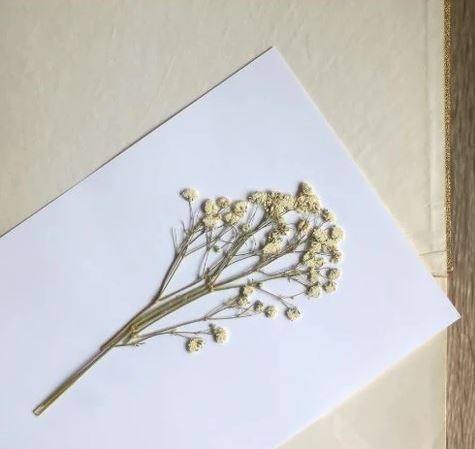
Drying flowers in a book typically takes two to four weeks, depending on factors such as the flower type, size, and environmental conditions.
Pressing flowers between book pages allows for a gradual preservation. This results in beautifully dried blooms that are completely dried out.
It’s best to choose flowers with relatively flat petals, such as daisies, pansies, or violets. These types tend to press more easily.
2. Dry Flowers Using A Press
Invest in a flower press, which is a specialized device designed for pressing flowers. It usually consists of two wooden boards with bolts that apply even pressure.
This DIY resin flower preservation method is not the quickest on this list. It’s great for those days when you want to spend the day doing something that is relaxing.
A flower press is a device designed specifically for the purpose of pressing flowers.
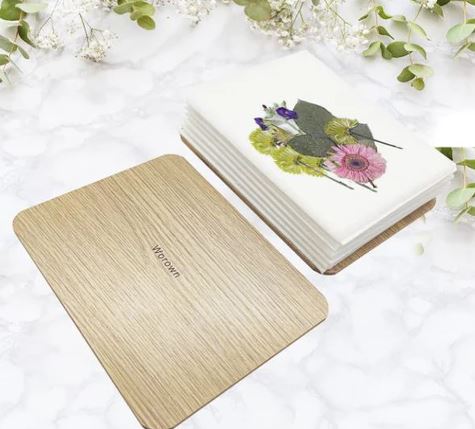
A flower press provides an efficient and controlled method for preserving flowers. It allows them to dry flat and retain their delicate beauty for a variety of artistic endeavors.
If you are wondering what the best way to dry flowers for resin, this is one of the most popular ways. Follow the instructions provided with the press for best results.
Drying flowers in a press usually takes around two to three weeks, depending on the specific flowers and environmental conditions.
The gentle compression and controlled airflow in a flower press facilitate the gradual removal of moisture. This preserves the flowers and yields beautifully dried specimens.
3. Microwave Drying Flowers
Microwaving is a quick method of drying flowers of larger sizes. While using a microwave to dry flowers is possible, it’s important to approach this method with caution.
Microwaving flowers for drying is a quick process. Note that it may not preserve their color and shape as well as more traditional methods like air-drying or pressing.
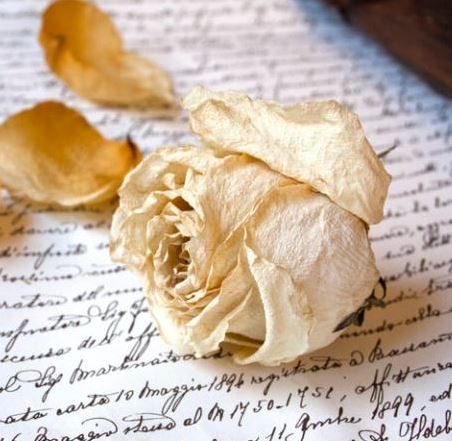
Place the flowers between two pieces of absorbent paper and put them in a microwave for short bursts of about 30 seconds at a time.
Check the flowers after each burst until they reach the desired level of dryness.
By placing flowers between layers of absorbent paper and microwaving them in short bursts, the heat gently removes moisture. This will preserve the flowers and allow them to retain their color and shape.
4. Microwave Flower Presses
Microwave flower presses provide a modern twist to the traditional method of pressing flowers. It will dry the flowers quickly so that you can use them right away. I have this press and it works great.
One thing to note is that when using a press like this, check on the flowers every 30 seconds so that they don’t scorch.
These presses have microwave-safe plates with layers of absorbent paper, allowing for a fast drying time without waiting.
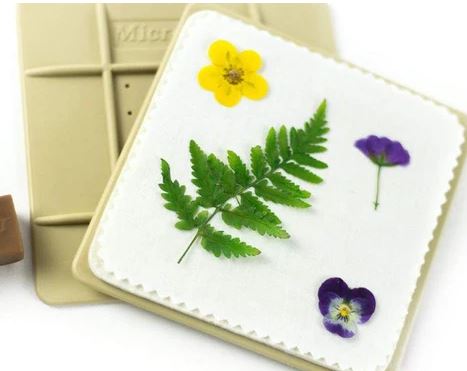
They use the heat generated from microwaving to speed up the drying time while still achieving beautifully preserved flowers.
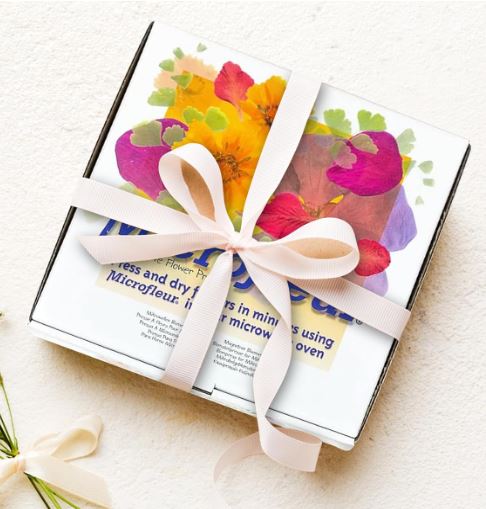
5. Silica Gel For Flower Preservation
Silica gel is a desiccant commonly used in flower preservation to effectively dry and preserve flowers while maintaining their shape and color.
It is a porous and granular substance that has a high capacity for absorbing moisture.
When using silica gel to preserve flowers, you begin by selecting fresh flowers at their prime and removing excess foliage and stems.
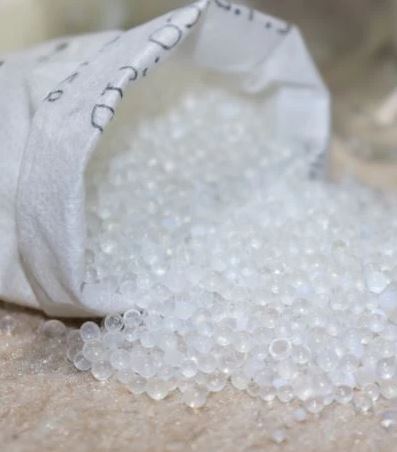
Next, you choose a container that can be sealed tightly, make sure it is large enough to hold all of your flowers without overcrowding.
Pour a layer of silica gel into the bottom of the container, so that it covers the entire surface. Gently place the flowers on top of the silica gel, making sure to position them in a way that maintains their desired shape.
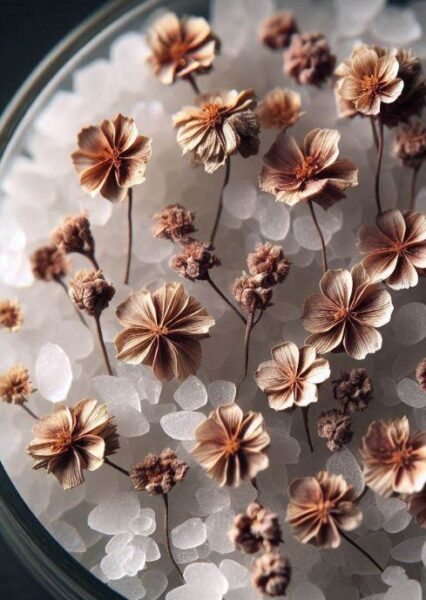
Pour more silica over the flowers covering them completely.
Seal the container tightly and place it in a dry and cool location, away from direct sunlight. Let the flowers sit undisturbed for approximately one to two weeks, or until they have thoroughly dried.
During this time, the silica gel will slowly absorb the moisture from the flowers, leaving them in a desiccated state.
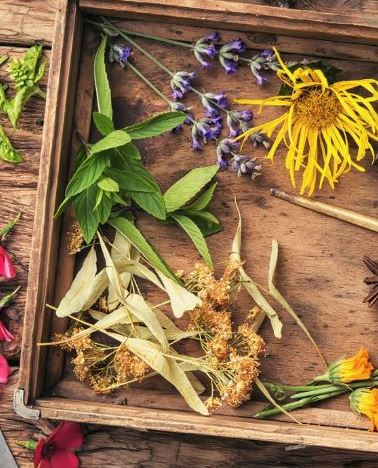
Once the drying period is complete, carefully remove the flowers from the silica gel, gently brushing off any excess gel that may cling to them.
The preserved flowers will retain their original shape, color, and texture, making them ideal for various decorative uses such as floral arrangements, cottagecore crafts, or jewelry-making.
6. Ironing Fresh Flowers For Drying
This method can be used to quickly press flowers. Place the flowers between two sheets of absorbent paper and set your iron to a low heat setting.
Gently iron over the paper for a few seconds, being careful not to apply too much pressure. Check the flowers to see if they are adequately dried, and repeat the process if needed.
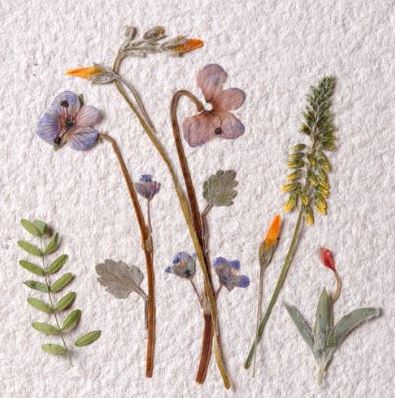
7. Freeze Drying Flowers for preservation
Freeze drying flowers is a specialized preservation technique that will give you some excellent results for long term preservation.
This method involves freezing the flowers at very low temperatures and then removing the moisture through a process called sublimation. The frozen water evaporates without going through the liquid phase.
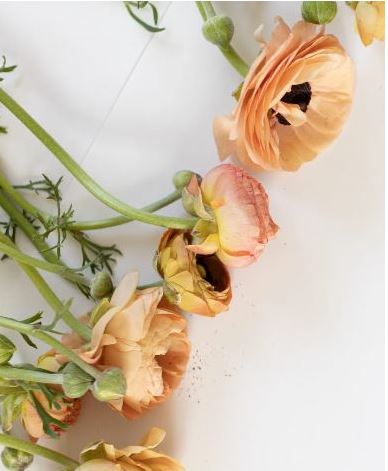
The end result is beautifully preserved flowers with minimal loss of color, shape, and texture.
This makes freeze drying a popular choice for creating floral displays and arrangements that retain their natural beauty for an extended period.
Freeze dryers are very expensive but you can turn your hobby into a business by selling your freeze dried creations. Freeze drying is extremely popular and you can offset the costs by making things to sell at craft shows and bake sales.
8. Glycerin Preservation
Glycerin preservation is a unique technique used to maintain the color, shape, and texture of flowers while keeping them pliable and soft.
Immerse the flowers in a mixture of water and glycerin, allowing the solution to be absorbed by the plant’s cells. This process replaces the natural moisture, preserving the flowers in a supple state.

This method is particularly popular for creating long-lasting floral arrangements, wreaths, and displays that maintain their beauty and flexibility, making glycerin preservation a favored choice for floral enthusiasts.
Drying flowers with glycerine is a relatively quick process, taking approximately one to two weeks for the flowers to absorb the glycerine solution and maintain their supple appearance.
This method not only accelerates the drying time but also preserves the flowers with a natural and vibrant finish.
9. Paraffin Wax Flower Preservation
Wax preservation is a charming and effective method for preserving flowers by encasing them in a protective layer of melted wax.
Melt paraffin wax or beeswax in a double boiler. Dip each flower individually into the melted wax, making sure to fully coat them. Remove the flower, gently shake off excess wax, and place it on wax paper to dry and harden.

By dipping the flowers into melted paraffin wax or beeswax, the wax acts as a sealant. The result will lock in the flowers’ natural colors and forms while providing a glossy and durable finish.
This preservation technique not only prolongs the lifespan of the flowers but also allows for a range of creative uses, such as incorporating them into candles, decorative crafts, or even as standalone wax flower displays.
Avoid utilizing the flowers for extended preservation projects like wedding flowers, for example since they have not undergone the proper drying process for long term.
Only use this method for things that do not require long term enjoyment.
10. Air Drying Flowers
Air drying flowers is a simple yet effective method of preserving their natural beauty. The process involves bundling the flowers together and hanging them upside down in a cool, dry place with good air circulation.
Over time, the moisture in the flowers evaporates, resulting in beautifully dried blooms that can be enjoyed for months or even years.
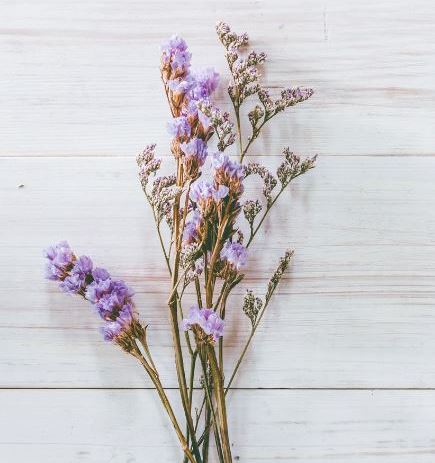
When air drying flowers, it’s important to choose flowers with sturdy stems and petals that retain their shape well when dried. Delicate and fragile flowers may not fare as well in this method.
Bundling the flowers together with a rubber band or string helps to maintain their shape while they dry.
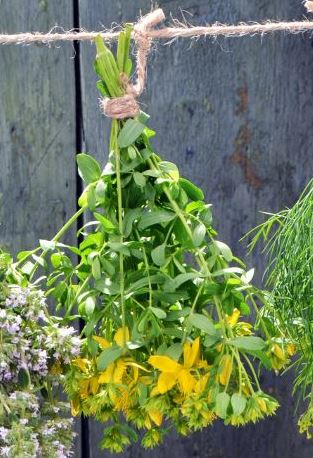
By hanging the bundled flowers upside down, you allow gravity to help retain their form and prevent the petals from wilting or drooping.
A well-ventilated area away from direct sunlight is ideal to prevent color fading and maintain the vibrancy of the flowers.
The drying time can vary depending on the type of flowers, their moisture content, and the environmental conditions.
It usually takes a few weeks for the flowers to completely dry, but it’s important to periodically check on them to make sure they are drying properly and not developing mold or rot.
11. Oven Drying Flowers
Oven drying flowers is a practical and accessible method for preserving their beauty at home.
It involves using a conventional oven to gently remove moisture from the flowers, resulting in dried blooms that can be used for various artistic and decorative purposes.
To oven dry flowers, start by selecting fresh flowers at their prime. Remove excess foliage and trim the stems to your desired length.
Preheat your oven to the lowest possible temperature, usually around 180 to 200 degrees Fahrenheit (82 to 93 degrees Celsius).

Place the flowers in a single layer on a baking sheet lined with parchment paper or a non-stick mat.
Make sure the flowers are not touching each other to for proper airflow and even drying. Avoid overcrowding the baking sheet to allow heat to circulate effectively.
Carefully place the baking sheet with the flowers into the preheated oven. Keep the oven door slightly ajar to allow moisture to escape. This helps prevent the flowers from getting cooked instead of dried.
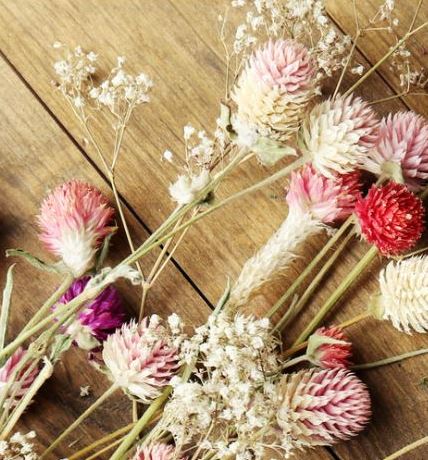
It’s important to note that oven drying works best for flowers with sturdy petals that can withstand the heat.
Delicate or highly fragrant flowers may not be suitable for this method, as they can lose their color or scent during the drying process.
It’s recommended to research specific flower types and experiment to determine which ones are most suitable for oven drying.
12. Dehydrator For Flowers
Using a food dehydrator for drying flowers provides a convenient and efficient method for preserving their beauty.
A food dehydrator is a machine designed to gently remove moisture from various foods, and it can be adapted for drying flowers as well.
Check out this Cosori review video. This one has many trays to dry lots of flowers quickly.
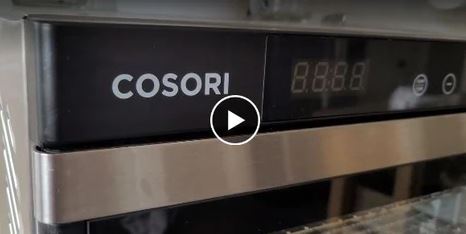
To dry flowers with a food dehydrator, begin by selecting flowers at their peak freshness.
Remove excess foliage and trim the stems to your desired length. Arrange the flowers in a single layer on the dehydrator trays so they are not overlapping.
Set the dehydrator to a low temperature, typically around 95 to 110 degrees Fahrenheit (35 to 43 degrees Celsius).
The low heat allows the flowers to dry slowly, preserving their color and shape. Keep in mind that drying times may vary depending on the type and moisture content of the flowers.
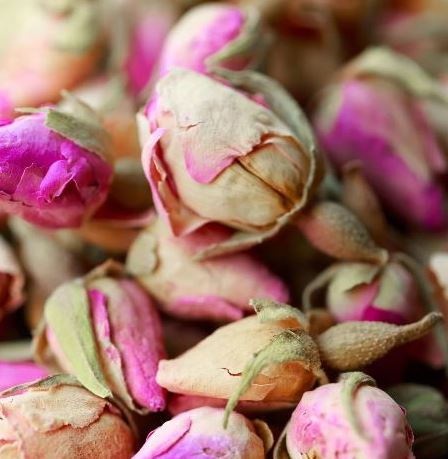
Most popular flowers to dry for resin
Rose (Rosa): The timeless beauty of roses makes them a popular choice for resin crafts, preserving both their shape and color.
Lavender (Lavandula): Known for its fragrant aroma and delicate appearance, dried lavender buds add a touch of elegance to resin projects.
Baby’s Breath (Gypsophila): These tiny, delicate flowers create an ethereal look in resin, adding a light and airy quality to your creations.
Daisy (Bellis perennis): Daisies retain their cheerful charm when dried, making them ideal for resin designs that radiate positivity.

Statice (Limonium): With its papery texture and vibrant hues, statice adds both texture and color diversity to resin art.
Hydrangea (Hydrangea macrophylla): The intricate, globe-like clusters of hydrangea flowers offer a captivating presence in resin creations.
Chrysanthemum (Chrysanthemum spp.): Drying chrysanthemums preserves their intricate petals, providing a unique and sophisticated touch to resin projects.
Marigold (Tagetes): The bold and warm hues of marigolds make them a striking choice for resin crafts, adding a burst of color and vitality.

Peony (Paeonia): Known for their lush and layered petals, dried peonies bring a touch of romance and opulence to resin art.
Queen Anne’s Lace (Daucus carota): The delicate, lacy appearance of Queen Anne’s Lace flowers imparts a touch of whimsy and intricacy to resin designs.
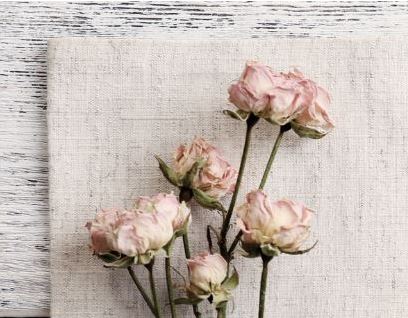
Tips for preserving flowers
Start With Moisture Free Flowers
Start with fresh flowers that are free from moisture. Dry them using a method such as air-drying or pressing before incorporating them into resin. This helps prevent excess moisture in the resin.
Consider Flower Size and Thickness
Choose flowers that are relatively small and thin, as they tend to dry more effectively in resin. Delicate petals and smaller blooms often yield better results, preserving intricate details when encapsulated in resin.
Press Flowers with Care
If pressing flowers, do so with care to maintain their natural form. Place flowers between absorbent paper and apply gentle, even pressure. This not only preserves the flowers but also prepares them for a smooth incorporation into resin.
Seal Dried Flowers Before Resin Casting
Make sure that the dried flowers are fully sealed to prevent moisture absorption from the resin. Consider using a clear sealant or a thin layer of clear glue to create a barrier between the flowers and the resin, preserving their appearance and preventing potential discoloration.
Avoid Highly Moisture-Prone Flowers
Steer clear of flowers that are naturally high in moisture content, as they may not fare well in resin. Examples include succulents or flowers with fleshy petals.
Experiment with Color Preservation
Test different drying methods to see how well they preserve the color of your flowers. Some flowers may lose vibrancy during the drying process. So experimenting with various techniques will help you find the method that best maintains the colors you need in your resin projects.
In Closing
Thanks for reading this guide. I hope you found it helpful! If you have a tried and tested way to dry your flowers for resin, leave a comment below. Happy crafting.



![9 Best Resins For Stabilizing Wood [2025]](https://craftydiyartistry.com/wp-content/uploads/2023/11/resin-for-wood-stabilizing-1b-600x499.jpg)
